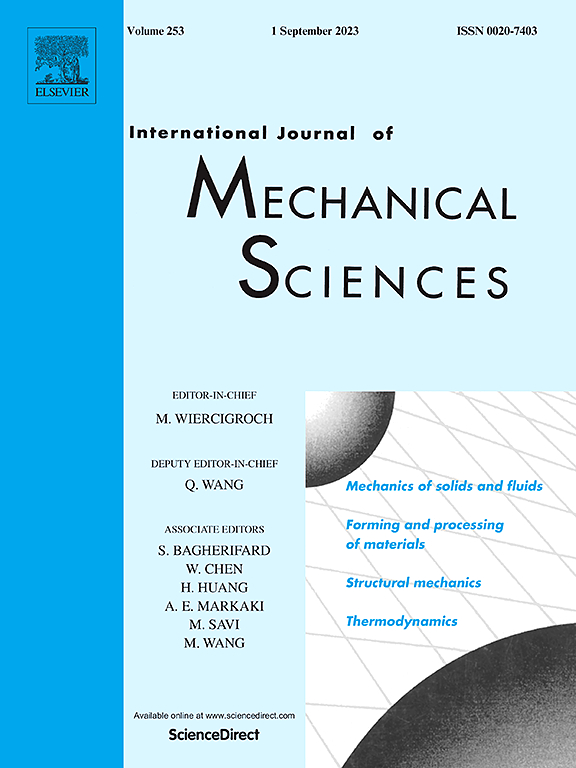Blood–brain mechanics: How brain tissue responds to pulsatile blood flow dynamics
IF 7.1
1区 工程技术
Q1 ENGINEERING, MECHANICAL
International Journal of Mechanical Sciences
Pub Date : 2025-04-25
DOI:10.1016/j.ijmecsci.2025.110278
引用次数: 0
Abstract
Highly coupled interactions between nonlinear fluids and soft matter are ubiquitous in nature and critical for various applications. A prime example is the blood–brain interaction, where the pulsatile non-Newtonian blood flow deforms the extremely soft and highly nonlinear human brain tissues. Understanding this dynamic is vital, as it can provide critical insights into neurological issues and their underlying mechanisms. However, experimentally investigating these interactions is less feasible due to the limited access to the human brain. Although advanced computational models have been developed to simulate blood flow in the human brain, a comprehensive model that can reconcile the various nonlinear components in a fully coupled framework to capture the specific interactions between the blood flow, vessel movement, and brain tissue dynamics remains elusive.
To explore the mechanisms governing blood–brain interactions, we have developed an innovative finite element model that seamlessly integrates the interactions between non-Newtonian blood flow, hyperelastic blood vessels, and hyper-viscoelastic brain tissue. This model is enhanced by a hyper-viscoelastic model based on compression–relaxation tests of human brain tissues, which can precisely capture their time-dependent nonlinear behaviour. Comprehensive simulations based on this model illustrate how pulsatile blood flow significantly deforms brain tissues under various scenarios. This study not only offers new possibilities for understanding the intimate links between brain function and its biomechanics, but also provides a novel modelling framework to solve complex interactions between nonlinear fluids and soft matter across several other scientific disciplines and fields.

血脑力学:脑组织对脉动血流动力学的反应
非线性流体与软物质之间的高度耦合相互作用在自然界中无处不在,对各种应用至关重要。一个主要的例子是血脑相互作用,其中脉动的非牛顿血流使极其柔软和高度非线性的人类脑组织变形。了解这种动态是至关重要的,因为它可以为神经问题及其潜在机制提供关键的见解。然而,实验研究这些相互作用是不太可行的,由于有限的访问人类大脑。尽管先进的计算模型已经被开发出来模拟人脑中的血流,但是一个全面的模型,可以在一个完全耦合的框架中协调各种非线性成分,以捕捉血流、血管运动和脑组织动力学之间的特定相互作用,仍然是难以捉摸的。为了探索控制血脑相互作用的机制,我们开发了一种创新的有限元模型,该模型无缝集成了非牛顿血流,超弹性血管和超粘弹性脑组织之间的相互作用。该模型通过基于人脑组织压缩松弛测试的超粘弹性模型得到增强,该模型可以精确地捕获其随时间变化的非线性行为。基于该模型的综合模拟说明了搏动血流如何在各种情况下显著变形脑组织。这项研究不仅为理解脑功能与其生物力学之间的密切联系提供了新的可能性,而且还为解决其他几个科学学科和领域的非线性流体与软物质之间复杂的相互作用提供了一个新的建模框架。
本文章由计算机程序翻译,如有差异,请以英文原文为准。
求助全文
约1分钟内获得全文
求助全文
来源期刊

International Journal of Mechanical Sciences
工程技术-工程:机械
CiteScore
12.80
自引率
17.80%
发文量
769
审稿时长
19 days
期刊介绍:
The International Journal of Mechanical Sciences (IJMS) serves as a global platform for the publication and dissemination of original research that contributes to a deeper scientific understanding of the fundamental disciplines within mechanical, civil, and material engineering.
The primary focus of IJMS is to showcase innovative and ground-breaking work that utilizes analytical and computational modeling techniques, such as Finite Element Method (FEM), Boundary Element Method (BEM), and mesh-free methods, among others. These modeling methods are applied to diverse fields including rigid-body mechanics (e.g., dynamics, vibration, stability), structural mechanics, metal forming, advanced materials (e.g., metals, composites, cellular, smart) behavior and applications, impact mechanics, strain localization, and other nonlinear effects (e.g., large deflections, plasticity, fracture).
Additionally, IJMS covers the realms of fluid mechanics (both external and internal flows), tribology, thermodynamics, and materials processing. These subjects collectively form the core of the journal's content.
In summary, IJMS provides a prestigious platform for researchers to present their original contributions, shedding light on analytical and computational modeling methods in various areas of mechanical engineering, as well as exploring the behavior and application of advanced materials, fluid mechanics, thermodynamics, and materials processing.
 求助内容:
求助内容: 应助结果提醒方式:
应助结果提醒方式:


